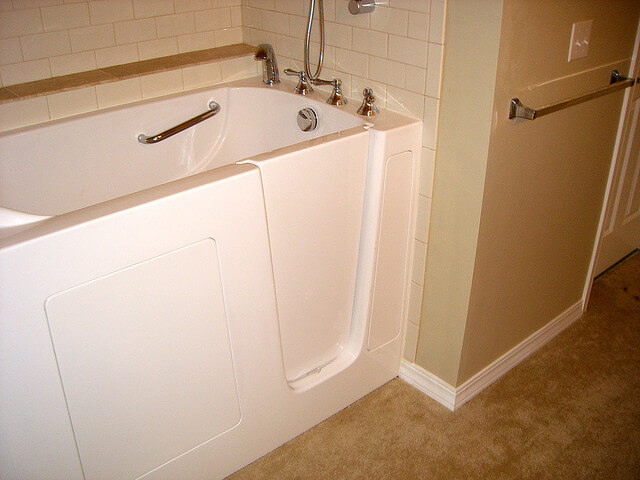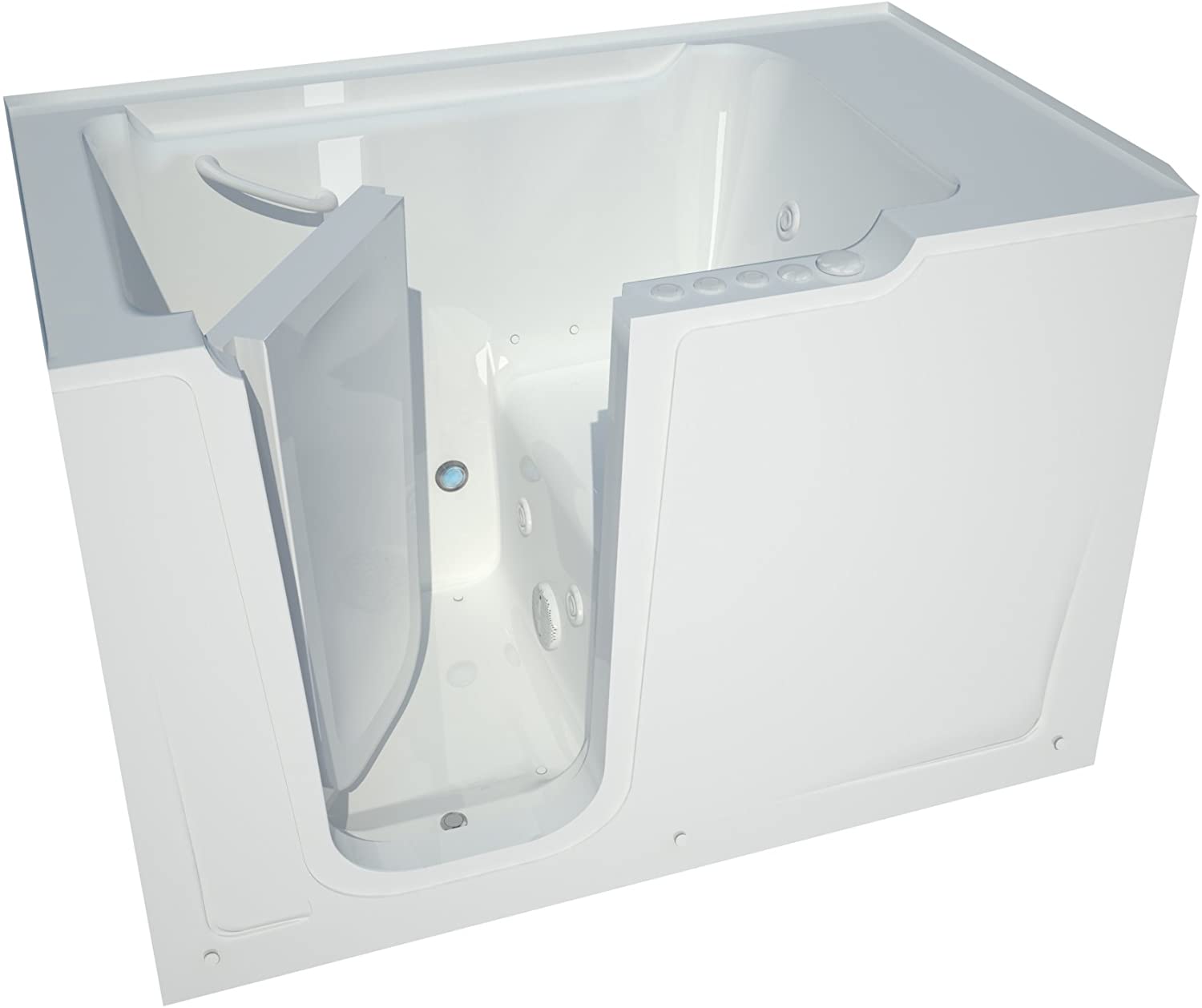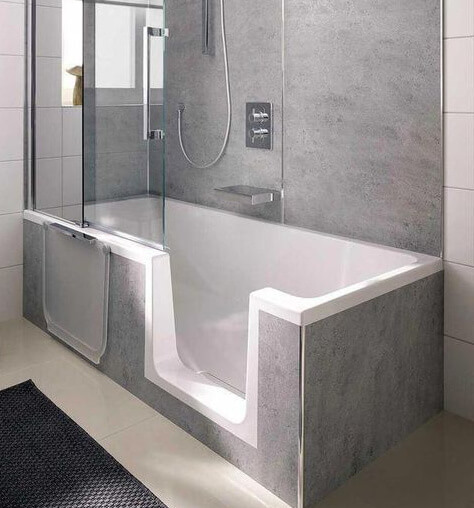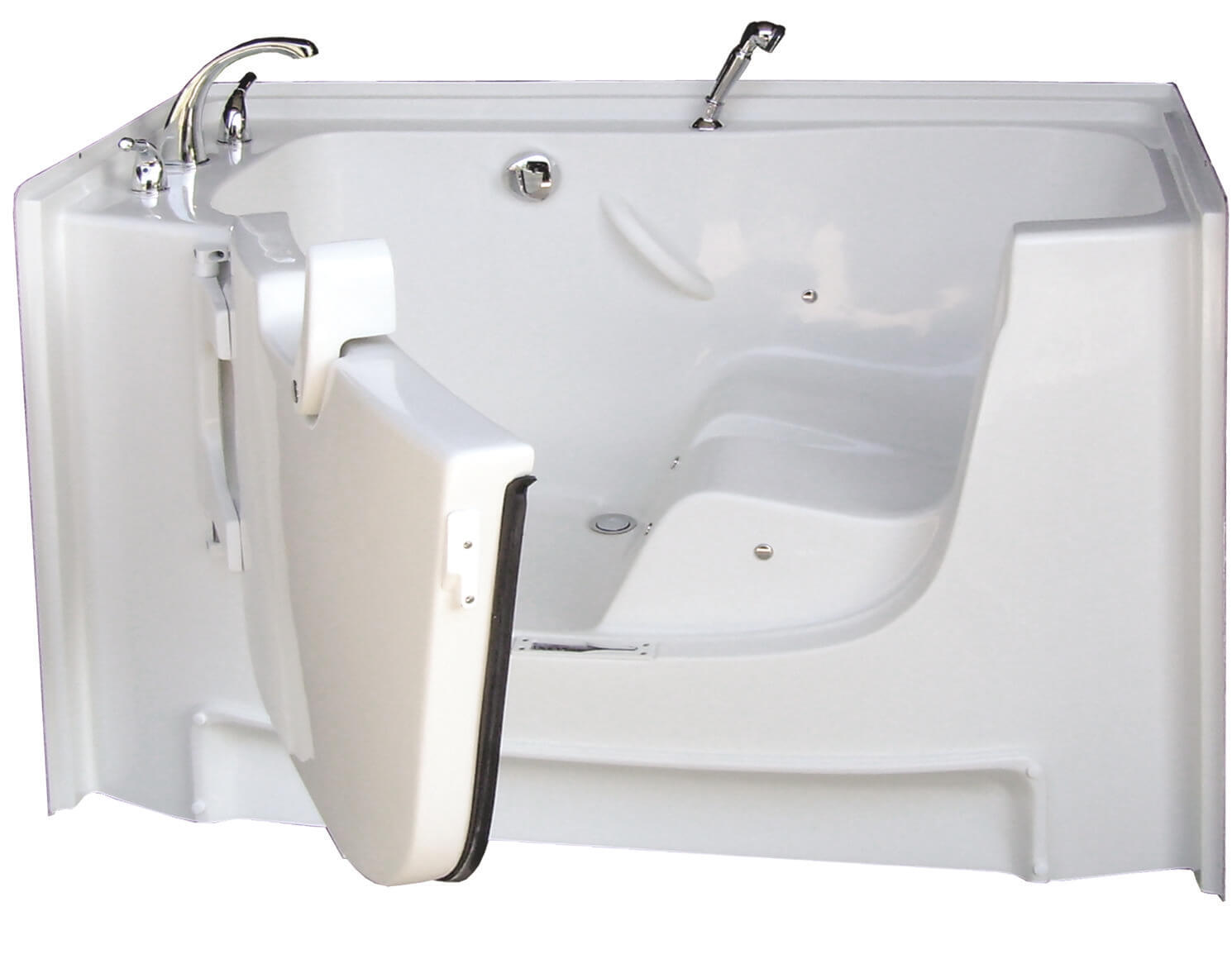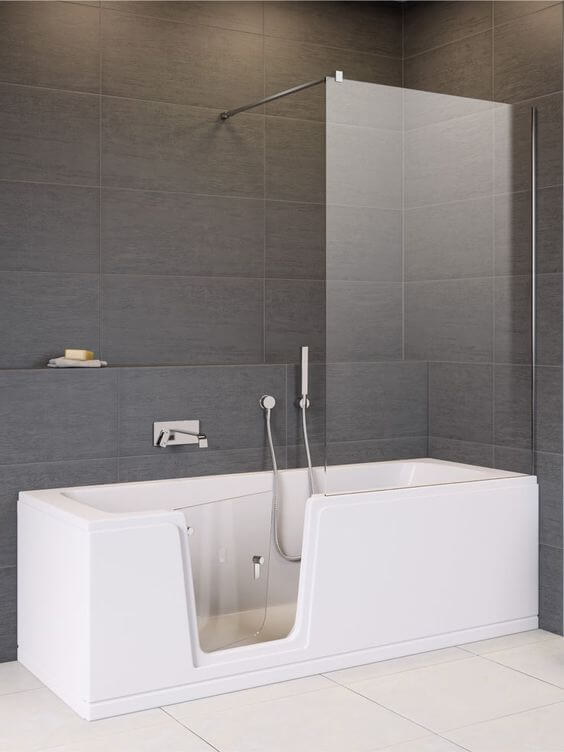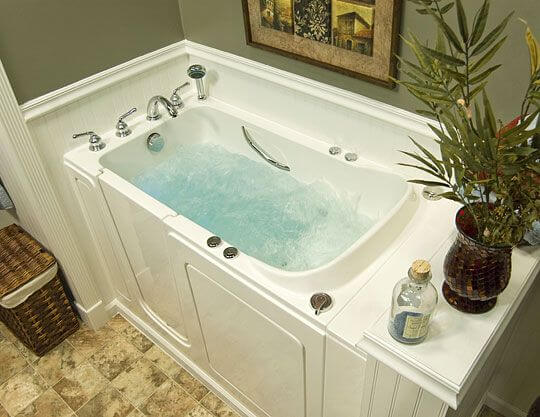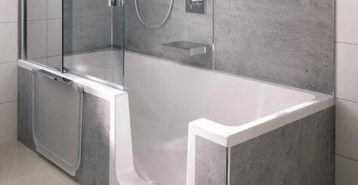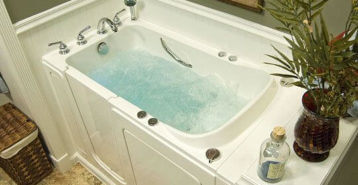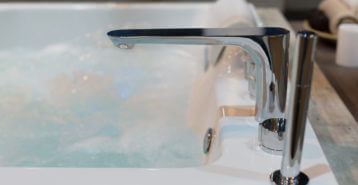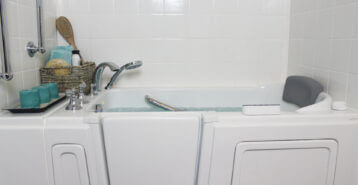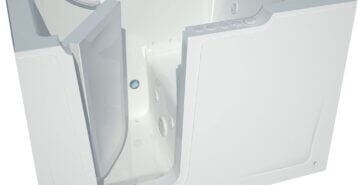Walk-in tubs for seniors come in seven main types, each suitable for different levels of mobility and different health concerns. With so many options, it can be overwhelming to choose the right type of walk-in tub that suits your specific needs. That’s why we’ve created this informative page to help you explore and understand the different types of walk-in tubs, including their features, benefits, and considerations.
Whether you’re looking for therapeutic features, space-saving designs, or specialized options, we’ve got you covered. Let’s dive in and discover the perfect walk-in tub that will transform your bathing experience.
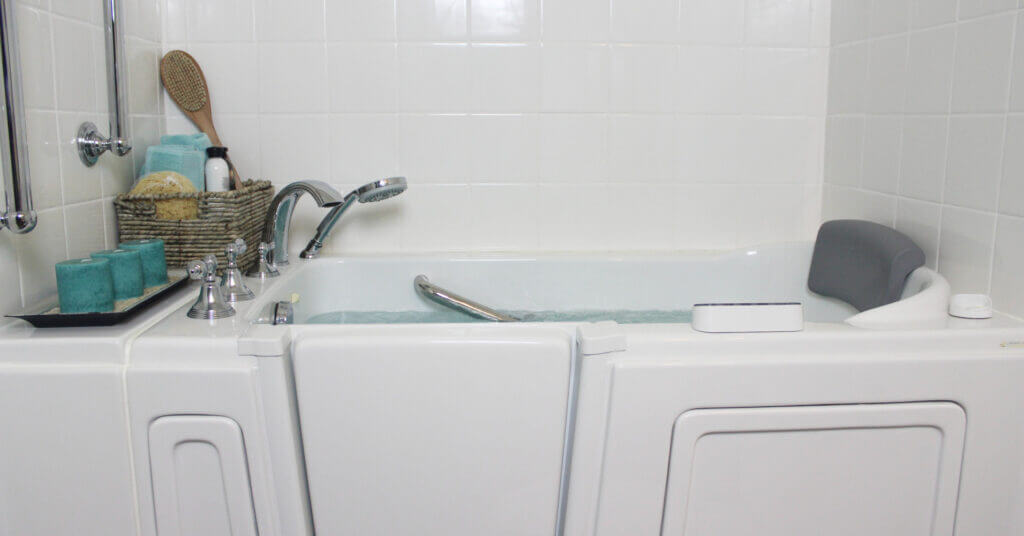
7 Types of Walk-in Tubs for Seniors
The below table lays out the names and main features of the seven different walk-in tub styles. You can start to narrow in right away on which options may be best for you.
| Walk-in Tub Style | Features | Average Installation Cost |
|---|---|---|
| Soaker walk-in tub | Standard tub with no jets | $3,500 - $7,500 |
| Bariatric walk-in tub | Larger tub for persons 300+ lbs | $4,200 - $11,500 |
| Walk-in tub shower combo | Attached showerhead with option to shower | $3,300 - $8,500 |
| Wheelchair accessible tub | Wider entryway to accommodate persons in wheelchairs | $4,500 - $11,500 |
| Lay down walk-in tub | Slightly longer with option to lay down and stretch out | $5,000 - $8,000 |
| Hydromassage walk-in tub | Whirlpool jets for relaxation or muscle soreness | $4,400 - $12,500 |
| Two-person walk-in tub | Larger tub that fits two bathers at the same time | $5,500 - $12,500 |
Now, let’s take a look at each tub type in more detail.
1. Soaker
- Best for: Anyone who wants all the safety features of a walk-in tub at the lowest price point.
Though the typical walk-in tub type is deeper than an average bathtub, soaker walk-in tubs are even taller, hold more water, and can allow someone to submerge comfortably to their shoulders. This can be wonderful for those who need hydrotherapy or enjoy the feeling of near-weightlessness they can obtain in water that deep.
Soaker walk-in tubs are considered standard in the walk-in tub industry. It is a go-to style if you are looking for a comfortable tub with standard features, and are looking to keep costs at a minimum. You can expect a soaker walk-in tub to cost approximately $3,500 to $7,500, depending on the brand.
These basic walk-in tubs come with all the standard safety features, like grab bars, anti-slip floors, a raised seat, and temperature protection.
2. Bariatric
- Best for: Bathers with larger bodies or anyone who would prefer a larger entry and seating area.
Designed to accommodate larger individuals, these tubs are longer and wider than the typical walk-in tub. They also come with larger doors and seats. This tub is built for those who weigh 300 to 600 pounds. As a basis of comparison, the typical walk-in tub supports up to 300 pounds.
Most bariatric tubs come equipped with low-entry thresholds, grab bars, anti-slip floors, quick drain technology, and easy locking handles built in.
A bariatric tub may be 50% larger than a traditional walk-in tub. They also use more water. Though most walk-in tub types are designed in a size that fits the space for a typical tub, bariatric tubs can be big enough to require some remodeling or construction in your bathroom during installation.
Due to their size, bariatric tubs tend to be more costly than your traditional walk-in tub model. The average cost of a bariatric walk-in tub can run anywhere from $4,200 to $11,500 on average. The cost can go up from there depending on the brand and additional features.
3. Shower Combo
- Best for: Families who have multiple people who will be using the same tub or anyone whose mobility allows them to shower safely and would like to have that option.
This is exactly what it sounds like – a walk-in tub with the addition of a shower. It looks very much like a typical bathroom’s tub/shower combo, only with the bonus of the walk-in function. It will be deeper and have a low threshold entryway to support the elderly or mobility challenged.
The shower often uses a curtain, though there are some models that can use clear acrylic walls as the shower surround. You may have to custom-build your walk-in tub shower combo, depending on your needs and the tub brand you choose. Your contractor will also need to consider the configuration of your bathroom and what you want the shower and tub combination to look like to give you an exact price.
All things considered, the cost of these combo units can run from $3,300 to $8,500 on average.
4. Wheelchair Accessible
- Best for: Any person who uses a wheelchair.
Wheelchair-accessible walk-in tubs, also known as roll-in tubs, offer safer bathtub access for those in wheelchairs. The entryway of the tub is wide enough and flat enough to allow for a standard wheelchair to easily roll into the bath. These tubs also have wider outward-facing doors and lower tub seats. This works well for those who use a wheelchair designed for the shower or those who can transfer from a wheelchair to a shower bench.
You can also expect safety features like grab bars and anti-slip flooring with these types of tubs. Some wheelchair-accessible tubs feature lifts and other safety features to make it even easier for those who are wheelchair-bound to enjoy a good soak without worry about injury.
The cost of a wheelchair-accessible tub can range widely, depending upon the features chosen. A good rule of thumb for pricing is between $4,500 and $11,500.
5. Lay-Down
- Best for: Bathers who need a low step threshold but have enough mobility to safely get up and down in the tub.
These types of walk-in tubs are longer than most and usually have an optional detachable seat. This can allow the user to lie back and relax if and when you would like. The lay-down walk-in tub can be especially helpful if you have a condition that makes it tough to sit upright. At the same time, it still has all the safety features and offers additional options, like adjustable head or armrests.
Keep in mind, however, that these might not fit in the space where your previous tub did, which could mean higher installation costs. You can expect a lay-down walk-in tub to measure approximately 60″ x 30″ L x 21″ H. They can be made to resemble a traditional alcove bathtub with white porcelain. Different brands will offer different door and finishing options.
The cost of the lay-down walk-in tub itself ranges from $5,000 to $8,000 on average.
6. Hydro Massage
- Best for: Anyone with chronic muscle pain or poor circulation.
These walk-in tubs might also be called hydrotherapy or whirlpool tubs. They work much like a traditional massage tub, with jets that work by forcing either water or air through them for a massage experience. Hydro massage walk-in tubs can be wonderful for relaxation. They also improve circulation and potentially target particular areas of the body, such as the back muscles to help those with chronic back pain.
This walk-in tub type can come with standard jets in various positions, or it can be customized. As you might imagine, the cost of these tubs is a bit higher than others, at anywhere from $4,400 to $12,500 on average.
7. Two-Person
- Best for: Anyone who will be bathing with a caregiver or households where more than one member will be using the walk-in tub.
A limited number of walk-in tub brands offer two-person tubs. Depending on the manufacturer you choose, you may be able to customize each side of the walk-in tub so it has the features most needed or most desired by each user. Two-person walk-in tubs tend to come in at the high end of the cost range, with average costs ranging from $5,500 to $12,500.
How To Choose A Walk-In Tub?
There are many different walk-in tub brands, each with its own unique takes on various walk-in tub styles. Here are a few ways to start to narrow in on the right choice for you.
- Make a budget: Only a few homeowners can pay for a walk-in tub out of pocket. Decide how much you feel comfortable spending, and then figure out if insurance or other sources of financial assistance will contribute to the overall expense. Many walk-in tub companies offer financing to cover whatever amount is left over. Knowing how much you are willing to spend and how much you are comfortable financing will help you figure out which company and which tub style may work for you.
- Identify your most important need: If what you most need from a walk-in tub is a low entry threshold and a handheld shower head, then you can comfortably choose from many (if not all) of the above walk-in tub types. However, if you have specific pain concerns — like sore muscles — or want to upgrade your bathing experience with a feature like built-in speakers, you’ll have a narrower field of choices.
- Measure your space: If you want to minimize costs, then you should plan to select a tub that fits into the space your current tub occupies.
- Call around: Several major walk-in tub brands will only give you pricing during an in-home demonstration. Plan to get quotes from three to four walk-in tub contractors. Be sure to ask about financing, tub features and options, and installation timelines.
Modernize can do the legwork for you if you do not want to do the research on your own. We can match you with up to four vetted contractors in your area who are taking on new clients and who have tubs that fit your space and your budget.
Compare top-rated walk in tubs pros in your area.
Read real homeowner reviews, explore qualifications, and view promotions. Modernize makes it easy to browse professionals and find one that will be perfect for your project.

